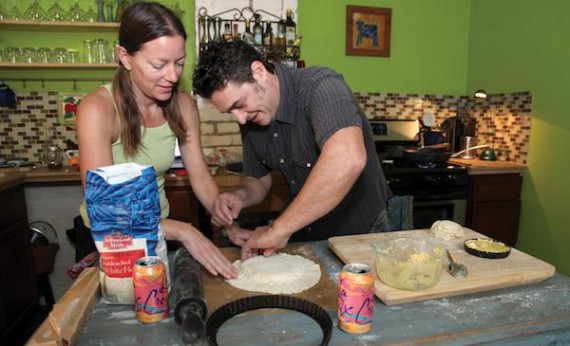“In France, you go to the bakery. The king cake is right there, under your nose. It’s cooked, ready to go, some of them still warm. Looks beautiful. It’s easy to just grab it from there and consume it. Eat it! Bakeries are there for that. Patisseries.
But you see, February, it’s the month of crêpes in France. The sixth of February is the great crêpe day. It’s huge. It’s a national thing. Everyone makes crêpes. King cake, in France, is more of a January thing. We celebrate the kings in January, for the Epiphany, after New Year, and then it’s over. But here, the king cake is related to Mardi Gras, from the Epiphany to Mardi Gras, and in France I think we lost the tradition of this—at the end of January, that’s it, it’s done. After that we don’t have king cake. But in Nice, in the south of France, we celebrate Mardi Gras, with parades and floats and everything. It’s very traditional and they have their own king cake and it looks more like the New Orleans king cake, like a ring, but instead of all the sugar, they put fruit on it. That’s their king cake.
Historically somewhere, something got shifted. New Orleans kept traditions that we lost in France, and meanings changed. That’s true for food, and other things too, like Joan of Arc. People use symbols to further their own cause. Like Petin, during the German invasion, used Joan of Arc in order to get the people to accept the invasion. But De Gaulle, with the liberation, he took her, her image and icon, and used it. Today, Joan of Arc is mainly used by the right-wing. The fleur-de-lis is another one. In New Orleans, it’s a symbol you see everywhere and there is no shame; in France, people are very uncomfortable when they see a fleur-de-lis. If you tattoo a fleur-de-lis on your arm in France, for the general public, it will have a meaning like royalty, sovereignty, blue blood; like you belong to the bourgeoisie, to the upper crust. Here, it’s just a symbol of New Orleans and Louisiana.
When we eat king cake in France, we put a small porcelain figure, a favor, in it too. Everyone sits at the table, the whole family, and the youngest has to go under the table while the adults cut the cake. Whoever finds the favor becomes king or queen and has to choose a king or queen from around the table. That’s why there are always two paper crowns on the king cakes in France. The favor in the king cake used to be a fava bean, like they use for St. Joseph’s day here, but they can be all kinds of shapes now, often biblical, like the Virgin Mary, or a lamb, or a character from The Simpsons. Sometimes they’re really nice; people collect them. They can be $50 or $60 each. Hand-made, hand-painted.
I bake tarts. My grandmother taught me. Tarts, and clafoutis with cherries, because we used to have a cherry tree. And crêpes, I love crêpes. And salade de carottes, grated carrots. I love that.
The mistake we made with this king cake is we forgot the chimneys, the holes. So the almond cream burst out the sides. It could rise up to a point and then it burst. Also, it’s a little thin. This recipe is not exactly what it’s supposed to taste like, but it’s close.
This is off the record, but I never liked the New Orleans king cake. It’s too sweet for me.”
French King Cake (Galette des Rois)
1/2 cup sugar
3/4 cup almond meal (Whole Foods)
1 tablespoon corn starch
1 pinch sea salt
9 tablespoons unsalted butter, soft
1 drop almond extract
1 tablespoon Cointreau
2 large eggs
1 lb all-butter puff pastry, thawed
1 egg yolk
1 tablespoon water
1 porcelain trinket or dried bean
1 tablespoon confectioner’s sugar
1 tablespoon hot water
Prepare the almond cream filling: In a bowl, combine sugar, almond meal, corn starch and salt. Stir until smooth. Mix with butter. Add extract and Cointreau, then eggs, one at a time, mixing well. Cover and chill for at least 1 hour.
Roll out puff pastry and cut two 12-inch rounds. Place one round on parchment paper and cover with almond cream, staying 1 inch from the edge all around. Combine egg yolk with water in a cup and brush the outer rim of the dough, avoiding the actual edge (this will prevent the dough from rising). Bury the trinket in the almond cream. Place the second round of dough on top, pressing down all around the sides to seal. Make a decorative pattern by scoring (but not piercing) the galette. Brush the top with egg wash.
Pierce 5 holes in the top, one in the center and four around the sides. Refrigerate (or freeze) for at least 1 hour. Bake on top of a cookie sheet at 350 degrees for 30 minutes. In the final minutes of baking, brush with a mixture of confectioner’s sugar and hot water for a shiny finish.





